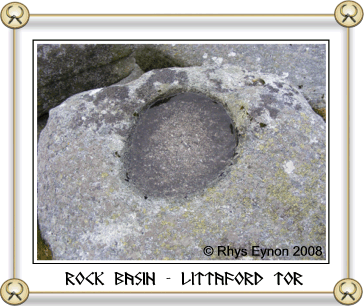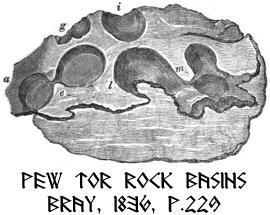
…’Tis said that here
The Druid wander’d. Haply have these hills
With shouts ferocious, and the mingled shriek,
Resounded, when to Jupiter upflam’d
The human hecatomb*. The frantic seer
Here built his sacred circle; for he loved
To worship on the mountains breast sublime –
The earth his altar, and the bending heav’n
His canopy magnificent. The rocks
That crest the grove-crow’d hill he scooped to hold
The Lustral Waters; and to wondering crowds
And ignorant, with guileful hand he rock’d
The yielding Logan…
(* a large scale sacrifice or slaughter)
N. T. Carrington – Dartmoor
Whilst recently walking around Littaford Tor we came across a small, water-filled rock basin which provided some inspiration for this page. Rock basins and their Druidical associations have been briefly mention elsewhere on this site but not in much depth so it may be prudent to examine the fact and fiction of these Dartmoor landscape features.
Firstly, what is a rock basin and how is it formed? The first question is easy, a rock basin is simply a dish-like hollow which can occur on the top of a rock. The latter question in theory should also be easy to answer but over the years it has been the subject of fierce debate. There was/is the point of view that they were naturally formed by processes of erosion and then there are those who refute this and consider that they were man-made, specifically by the ancient Druids. Admittedly in recent times modern understanding of geology and archaeology has virtually settled the matter but there are still a few who would like to think of them as mystical relics of a by-gone race of people.
So, to look at the rationally excepted modern idea. Rock basins are a product of localised weathering and are formed when weak feldspar crystals are split by the frost along their cleavages. This loosens small fragments which are later blown away by the wind thus leaving a small hollow. The process continues and gradually the hollow expands outwards and downwards. Water fills the hollow and then freezes, upon thawing more fragments are eroded which once again are blown away by the wind. The same effect can be obtained by the simple action of rainwater collecting in a hollow and then as it evaporates in warm conditions it will remove small amounts of the surface material over time the hollow widens and deepens and eventually a rock basin is formed. To get some idea of what a rock basin looks like the illustration below shows a small basin we found on Littaford Tor, for other examples click on the Dartmoor Archive links opposite,

There are numerous examples of rock basins on Dartmoor but some of the more notable are to be found on Kes Tor, Hel Tor, Pew Tor, Gutter Tor, Mel Tor and Bag Tor. Probably the most famous of Dartmoor’s rock basins is that found on Great Mis Tor, this is Mis Tor Pan, often referred to as the ‘Devil’s Frying Pan’ because it was he who was have meant to formed it for use in his evil rites, (Hemery, 1983, p.1020). Other rock basins have acquired their own names such as; ‘The Punchbowl’ (a rock near Rushford Tower), Mrs Bray’s Wash Basin (Over Tor) and ‘The Pixie’s Pond’ (Pew Tor).
During the early 1800s there was the other theory, namely that the Druids carved the basins in order to use them either in their rituals or as cisterns to collect pure rainwater which would then be used in their ceremonies. It appears that this idea started with the noted Cornish antiquarian – W. C. Borlase. In an early encyclopaedia of antiquities published in 1825 the following definition appears: ‘Rock-Basins are cavities cut in the surface of a rock, of two kinds: one, simple cavities for reservoirs to preserve the rain or dew in its original purity, for the religious uses of the Druid; the other with lips, or communications between the different basins… Borlase says that they were used for libations of blood, wine, honey or oil‘, ( Fosbroke, 1825 p.75).
A great Dartmoor supporter of the Druidical theory was Samuel Rowe who in 1830 presented a paper to The Plymouth Institute where he noted the following: ‘Of almost all the relics of Druidical antiquity, the moorland districts of Devonshire afford specimens, which generally speaking, have been most imperfectly and unsatisfactorily noticed by antiquarians… Yet on the moor and within its precincts, are to be found examples of the sacred circle – avenues – the cromlech – the kistvaen – the rock idol – rock basin – monumental pillar – the cairn, or barrow – dwellings and trackways… But none of these observations here applied to the Logan stone and rock idol, appear to bear upon the rock basin, although some authors have attributed them to the formation of nature, by the action of water, and from the decomposition of some parts of the rock more than others. It seems extraordinary however, that any one who has examined these singular relics of antiquity, should advocate an opinion so devoid of the confirmation of the facts. Were the rock basins natural productions, why are they found so uniform in size? Why are they so frequently seen on those parts of granite masses less favourable than other parts to their natural formation? Their situation is commonly on the highest spot of the loftiest pile of the tor, very often near the edge of the block upon which they are formed, – in many instances with a lip or channel to convey the water over the edge of the mass, and generally varying in diameter from twelve inches to thirty six‘, (Rowe 18 pp. 179 – 189).
At this time it appears the ideas of Borlase had spread across from Cornwall into Devon because in order to answers his own questions Rowe went on to aver:
‘That this rude and primitive species of basin formed part of Druidism, there can little doubt remain; but the specific purpose for which they were constructed has excited much inquiry, and no small controversy… The hypothesis that they are formed on the loftiest tors for the purpose of obtaining water for lustration, in a state freest from earthy pollution, is far more probable, and derives string confirmation from the situations in which they are so frequently found‘, (Rowe, 18 pp. 189 – 190).
So, on Dartmoor the thinking of the mid 1800s was that the basins were used to collect rainwater which when collected from the basins was considered pure, this would then be used for purification purposes in rites and ceremonies (lustration). This idea soon took on amongst other Dartmoor antiquarians such as Mrs Bray. In 1836 she visited Pew Tor and describes what she saw: ‘That this rock was appropriated by the Druids to their religious uses is without doubt; as it not only possesses the singularities above described, but also several basins on its top‘, (Bray, 1836, p.227). The good lady even provided a sketch of the Pew Tor basins as she did with several others for around the moor, such was here fixation with the Druids:

Incidentally, the Druids and their practices was a passionate interest held by her husband who virtually converted their land to a Druidical landscape – see The Mystical World of Mr Bray. Later topographical writers such as Lloyd Warden Page began casting some doubt on the Druidical theory. Whilst explaining both arguments and admitting that initially he was a believer in the mystical idea he does confess to finally dismissing the theory in favour of natural formation, (Page, 1895, pp. 16 – 17). It was however, R. N. Worth who blew the whole concept apart when in no uncertain terms he penned the following; ‘The Dartmoor Druid was a wholly artificial product, given to practices of lustration, of sprinkling holy water, and of human sacrifice accompanied by the disgusting habit of catching blood of his victim. His originators seized with eagerness upon the rock-basins as the sacred receptacles by him formed and appointed for the various uses which his proposed practices suggested. The battle has been fought, and the geologists have won; these basins are now fully recognised as of natural formation‘, (1988, p.28).
About the same time William Crossing wrote a similar version noting that they were, ‘ascribed to the Druids until the geologist refused to allow them have hand in the matter, (1990, p.33). The death knell had rung for all of those who has visions of Druids performing barbaric rites on the granite tors of Dartmoor. Today it is laughable that such eminent and learned people should labour under such a misconception and falsely impart such ideas, or is it?
There can be no doubt that the rock basins were naturally formed but does that mean to say that prehistoric man didn’t use them in their rites and ceremonies? Nobody can prove that they didn’t just as they can’t prove they did. But, over recent years there has been a great interest in prehistoric rock art, part of which encompasses ‘cup marked stones‘. These are basically stone and rocks that have shallow, scooped hollows on them which are thought to have been pecked out by early man. Butter, (1999, p. 64) suggests that one of their purposes may have been in a ritual context where initiation rites took place. There are three known examples on Dartmoor which compared to other prehistoric upland landscapes is surprisingly small. Could it be that there was no need to carve such stones as there were already plenty of the like in-situ on the granite tors in the form of rock basins? Such rock hollows clearly have had some significance in the beliefs of Dartmoor or else why would the paying of rents at the Dunstone been so important, this is a large boulder with a hollow or basin in the top. Not only were rents paid there but manorial courts convened at the site, again a ritual throw-back from earlier times? What is a church font? Basically a hollowed out slab of rock that holds holy water which is used to initiate people into the Christian faith, apart from the size and ornate decoration it’s not dissimilar to a tor with a rock basin in it. So who did get it right and who got it wrong? Not even English Heritage are that sure as can be seen from their Pastscape Record for Mistor Pan – see HERE.

Bray, E. 1836. Legends, Superstitions and Sketches of that part of Devonshire on the Borders the Tamar. London: Murray.
Butter, R. 1999. Kilmartin. Kilmartin: The Kilmartin Trust.
Crossing, W. 1990. Crossing’s Guide to Dartmoor. Newton Abbot: Peninsula Press.
Fosbroke, T. D. 1825. Encyclopaedia of Antiquities and Elements of Archaeology – Vol I. London: John Nichols and Son.
Hemery, E. 1983. High Dartmoor. London: Hale Publishing.
Page, J. Ll. W. 1895. An Exploration of Dartmoor. London: Seeley and Co.
Rowe, S. 1830. Antiquarian Investigations in the Forest of Dartmoor. Transactions of the Plymouth Institute. pp. 180 -190.
Worth, R. N. 1988. Worth’s Dartmoor. Newton Abbot: David and Charles.
 Legendary Dartmoor The many aspects past and present of Dartmoor
Legendary Dartmoor The many aspects past and present of Dartmoor
